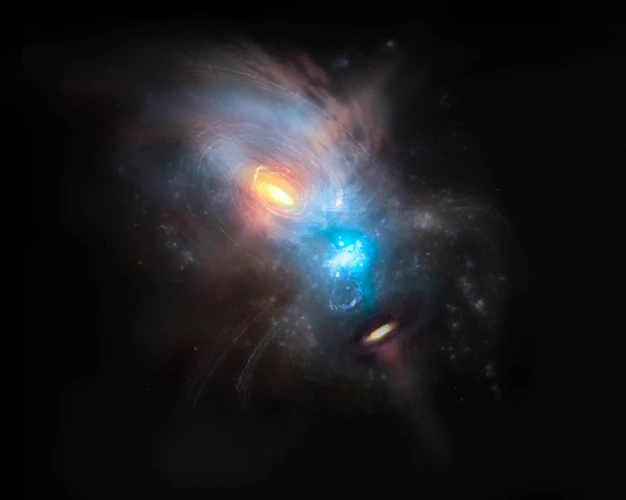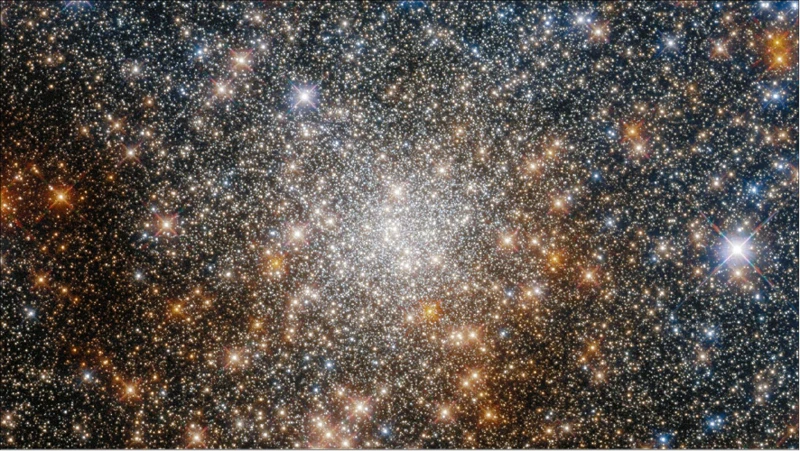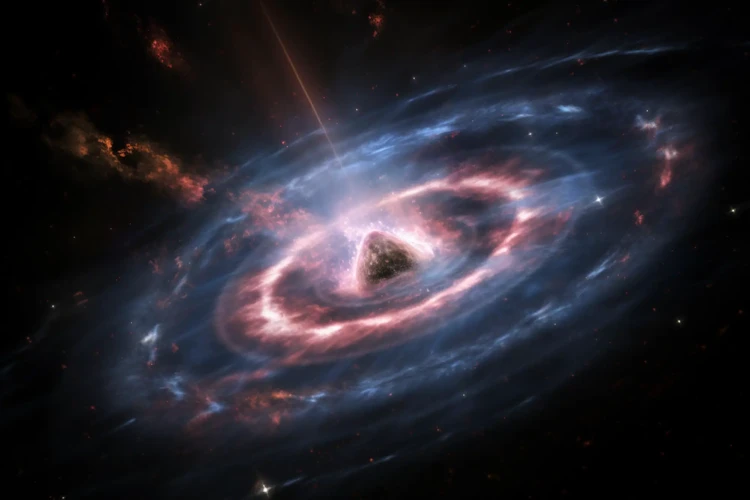Black holes and quasars have long fascinated scientists and astronomers alike, revealing the mysterious depths of our universe. These cosmic phenomena hold immense power and provide a window into the workings of the universe on both macro and micro scales. Black holes are enigmatic gravitational monsters that devour everything in their path. They possess such immense gravitational force that not even light can escape their clutches. On the other hand, quasars are incredibly luminous objects that emit radiation far beyond the capabilities of normal galaxies. While seemingly different, there is a profound link between these celestial objects that unveils hidden connections within the cosmos. In this article, we will explore the fascinating relationship between black holes and quasars, delving into their definitions, characteristics, and the remarkable observations that tie them together.
Contents
- What are Black Holes?
- Understanding Quasars
- The Relationship between Black Holes and Quasars
- Observational Evidence
- Theoretical Explanations
- Conclusion
-
Frequently Asked Questions
- What happens if you fall into a black hole?
- Can black holes die?
- Can you see a black hole?
- What is the event horizon of a black hole?
- Do black holes exist in our galaxy?
- What is the Schwarzschild radius of a black hole?
- What is a singularity in a black hole?
- How do black holes affect time?
- Are there any known black holes in binary systems?
- Can black holes be used for time travel?
- References
-
Frequently Asked Questions
- 1. Can black holes and quasars exist without each other?
- 2. What is the main difference between black holes and quasars?
- 3. How are quasars discovered?
- 4. Are all black holes associated with quasars?
- 5. How do black holes accrete mass?
- 6. Can quasars exist outside of galaxies?
- 7. Why are quasar host galaxies important?
- 8. How do astronomers study the properties of quasars?
- 9. Can black holes emit jets of particles?
- 10. Are there alternative theories to explain the link between black holes and quasars?
- References
- Read More
What are Black Holes?

Black holes are fascinating cosmic entities that have captured the imagination of scientists and curious minds alike. They are peculiar regions in space where gravity is so intense that nothing, not even light, can escape their grasp. These celestial objects are formed from the remnants of massive stars that have undergone a cataclysmic event known as a supernova. During this explosive event, the remains of the star collapse under their own gravitational force, compressing all of its mass into an infinitely small point called a singularity. This singularity is surrounded by an event horizon, a boundary beyond which nothing can escape the gravitational pull of the black hole. Black holes come in various types, including stellar-mass black holes, which are formed from the collapse of massive stars, and supermassive black holes, which can contain millions or even billions of times the mass of our sun. The study of black holes allows scientists to explore the extreme gravitational forces present in the universe, providing valuable insights into the nature of space and time. Understanding black holes is crucial in comprehending their connection to other cosmic phenomena, such as /quasars and the overall structure of the universe.
Definition and Characteristics
Definition and Characteristics of Black Holes
Black holes are mesmerizing astronomical objects with unique defining characteristics. They are regions in space where the gravitational pull is so strong that nothing, not even light, can escape their grasp. The defining feature of a black hole is its event horizon, which is the point of no return beyond which anything entering it cannot escape. The event horizon is formed by the immense gravitational force caused by the singularity at the center of the black hole. The singularity is an infinitely small and dense point where the mass of the collapsed star is concentrated. One peculiar characteristic of black holes is their immense gravitational force, which distorts space and time around them. This phenomenon is known as spacetime curvature. As an object approaches a black hole, it experiences a process called spaghettification, where it gets stretched and squished due to the intense gravitational pull. The size of a black hole is typically measured by its Schwarzschild radius, which represents the distance from the singularity to the event horizon. This radius depends on the mass of the black hole. Black holes can vary in size, from stellar-mass black holes with a few times the mass of our sun to supermassive black holes found at the centers of galaxies, containing millions or billions of solar masses. Exploring the definition and characteristics of black holes helps us understand the intriguing nature of these cosmic enigmas and their profound impact on the fabric of the universe.
Formation and Types of Black Holes
Formation and Types of Black Holes:
There are different mechanisms through which black holes can be formed, each resulting in distinct types of black holes. One type is stellar-mass black holes, which form from the death of massive stars. When a star exhausts its nuclear fuel, it undergoes a supernova explosion. The core of the star collapses under its own gravity, forming a black hole. These black holes typically have a mass ranging from about 5 to 100 times that of our sun.
Another type is the supermassive black holes, which exist at the centers of most galaxies, including our own Milky Way. The formation of supermassive black holes is still a topic of active research, but it is believed that they can grow through a process called accretion. This occurs when surrounding matter, such as gas and dust, falls into the black hole, releasing energy in the form of radiation.
One of the possible pathways for the formation of supermassive black holes is the growth of smaller black holes over time. These smaller black holes merge together, resulting in a supermassive black hole. Another theory suggests that supermassive black holes may form from the direct collapse of massive gas clouds in the early universe.
It’s important to note that black holes can vary in size, with some being relatively small and others being supermassive. The size of the black hole depends on the amount of mass it contains. The tremendous gravitational pull of black holes shapes the fabric of space and time around them, creating a fascinating environment that scientists continue to study and unravel. To better understand the relationship between black holes and other celestial phenomena, such as /quasars, further exploration and analysis are essential.
Understanding Quasars

Quasars are enigmatic objects located at the heart of galaxies that emit incredibly powerful and intense radiation. The term “quasar” stands for “quasi-stellar radio source” as they were initially discovered as radio sources with properties similar to stars. However, further observations revealed their extraordinary nature. Quasars are among the most luminous objects in the universe, outshining even galaxies that contain billions of stars. They are believed to be powered by supermassive black holes at their centers, which are surrounded by a swirling disk of hot, accreting matter. As this matter spirals into the black hole, it releases vast amounts of energy in the form of light and other electromagnetic radiation. Unlike stars, quasars do not derive their energy from nuclear fusion but rather from the gravitational potential energy of matter falling into the black hole. The discovery and classification of quasars have allowed astronomers to gain a better understanding of the early universe and the processes that shape galaxies. It has also shed light on the interplay between black holes and quasars, revealing their intricate relationship. To further unravel the mysteries of quasars, scientists delve into their properties, behavior, and connection with their host galaxies. Exploring the realm of quasars provides us with invaluable insights into the very fabric of our universe and its evolution.
Definition and Properties
Definition and properties of black holes are central to understanding these enigmatic cosmic objects. As previously mentioned, black holes are regions in space where gravity is extraordinarily strong, resulting in an intense gravitational pull. Their defining characteristic is the event horizon, which marks the boundary beyond which nothing can escape, not even light itself. This concept is a consequence of Einstein’s theory of general relativity, which explains how gravity works on a large scale. The properties of black holes are fascinating and often mind-boggling. For instance, black holes have immense mass packed into a minuscule volume, creating a gravitational force that distorts space and time around them. This phenomenon is known as gravitational time dilation, where time appears to slow down near a black hole compared to a distant observer. Another peculiar property is the gravitational tidal forces near a black hole, which can stretch and squeeze objects to extreme lengths. These unique characteristics make black holes a subject of great interest and exploration in the field of astrophysics. To further understand the intricacies of black holes, scientists study their relationship with /quasars and investigate various observational and theoretical aspects.
Discovery and Classification of Quasars
The discovery and classification of quasars have played a crucial role in our understanding of the universe. Quasars, short for “quasi-stellar radio sources,” were first identified in the 1960s as mysterious and extremely bright objects. Initially, they were observed as radio sources with no distinguishable optical counterpart. However, further studies revealed that these radio sources were associated with distant galaxies. The true nature of quasars was uncovered through the use of spectroscopy, which showed that they possessed highly redshifted emission lines. This redshift indicated that quasars were located at vast distances from Earth, making them some of the most distant and ancient objects in the universe. The classification of quasars is primarily based on their emission properties. There are various subtypes, including radio-loud and radio-quiet quasars, broad absorption line quasars, and blazars. The study of quasars has provided valuable insights into the early universe, the evolution of galaxies, and the dynamics of supermassive black holes at their cores. By analyzing the interactions between quasars and other celestial objects, such as /analyzing-interactions-libra-gemini/, scientists continue to unravel the mysteries of the cosmos.
The Relationship between Black Holes and Quasars

The relationship between black holes and quasars is a captivating field of research that has uncovered intriguing connections in the cosmos. One key aspect of this relationship is the phenomenon of mass accretion. When matter, such as gas or dust, falls into a black hole’s gravitational pull, it forms an accretion disk around the black hole. As the matter spirals inward, it heats up and emits tremendous amounts of energy. This energy release is what makes quasars so bright and luminous. Quasars are considered a type of active galactic nucleus (AGN), with the accretion disk surrounding a supermassive black hole at the center of a galaxy. In fact, supermassive black holes are often found at the hearts of galaxies, and their activity as quasars can have a profound effect on the evolution and dynamics of their host galaxies. Despite their different observable manifestations, the link between black holes and quasars is rooted in the process of mass accretion and the immense energy released as a result. Understanding this relationship allows astronomers to investigate the role of black holes and quasars in the overall evolution and structure of the universe.
Mass Accretion in Black Holes
Mass accretion in black holes plays a vital role in understanding their behavior and the powerful phenomena associated with them, such as /quasars. When black holes are in close proximity to other celestial objects, such as stars or interstellar gas clouds, their intense gravitational pull can cause these nearby materials to be pulled towards the black hole. As these materials spiral closer, they form a disk-like structure known as an accretion disk. The accretion disk is composed of gas, dust, and other matter that gradually spirals inward due to the gravitational attraction of the black hole. This process generates immense heat and friction, causing the disk to emit high-energy radiation, including X-rays and gamma-rays. The black hole steadily gains mass as it absorbs the matter from the accretion disk. The rate at which this mass accretion occurs determines the level of activity exhibited by the black hole. In some cases, black holes can become extremely active, emitting intense bursts of energy and radiation, giving rise to the phenomenon of a quasar. Studying mass accretion in black holes allows scientists to gain insights into the dynamics of these gravitational powerhouses and further investigate their connection to other cosmic phenomena.
Quasars as Active Galactic Nuclei
Quasars are intriguing astronomical objects that are classified as active galactic nuclei (AGN). AGN refers to the central regions of galaxies that exhibit unusually high levels of luminosity and energy emissions. Quasars, short for “quasi-stellar radio sources,” were first discovered in the 1960s and were initially considered to be stars due to their point-like appearance. However, further observations revealed that quasars are, in fact, located at the centers of galaxies, millions or even billions of light-years away from Earth. The extraordinary brightness of quasars is attributed to the presence of supermassive black holes at their cores. These supermassive black holes are surrounded by a swirling disc of hot gas and dust known as an accretion disk. As matter falls into the black hole, the intense gravitational forces cause the release of tremendous amounts of energy. This energy is emitted in the form of intense radiation, making quasars the most luminous objects in the known universe. The study of quasars and their connection to AGN provides valuable insights into the processes taking place at the centers of galaxies and the role that supermassive black holes play in the evolution of these cosmic structures.
Supermassive Black Holes and Quasars
Supermassive black holes and quasars are intimately connected, with the former being closely linked to the latter. Supermassive black holes are a type of black hole that possess incredibly large masses, ranging from millions to billions of times the mass of our sun. These behemoth black holes reside at the centers of most galaxies, including our own Milky Way. While the exact process of their formation is still a topic of research and debate, it is believed that they grow through a variety of mechanisms, such as accretion of surrounding matter and merging with other black holes. When matter, such as gas and stars, falls into the gravitational pull of a supermassive black hole, it forms an orbiting disk known as an accretion disk. This disk becomes highly energetic and releases an enormous amount of light and radiation. This intense radiation emission is what gives rise to the phenomenon known as a quasar. Quasars, short for “quasi-stellar radio sources,” are among the most distant and luminous objects in the universe. They appear as extremely bright points of light, resembling stars, but with distinctive emission spectra. The connection between supermassive black holes and quasars lies in the fact that the release of energy from the accretion disk surrounding the black hole powers the luminosity of the quasar. In other words, the supermassive black hole at the core of a galaxy is essentially the engine behind the quasar’s brilliance. This symbiotic relationship between supermassive black holes and quasars sheds light on the intricate and dynamic nature of galactic evolution and the interplay between gravitational forces and cosmic luminosity. Understanding this connection is essential in unraveling the mysteries of our universe and its vast structures. For more information on rare and mysterious cosmic phenomena, take a look at our article on /rare-mysterious-zodiac-signs/.
Observational Evidence

Observational evidence plays a crucial role in furthering our understanding of the relationship between black holes and quasars. Through detailed observations and analysis, astronomers have been able to gather compelling data that supports the connection between these cosmic phenomena. One key piece of evidence comes from the study of quasar host galaxies. Observations have revealed that quasars are often found in the centers of galaxies, suggesting a strong gravitational interaction between the central black hole and the surrounding matter. These host galaxies exhibit characteristics such as high rates of star formation and intense radiation, indicating the presence of an active galactic nucleus powered by the black hole. Additionally, emission lines observed in the spectra of quasars offer valuable insights. These lines correspond to specific wavelengths of light emitted by various elements and compounds. By analyzing the spectral lines, astronomers can determine the composition and movement of matter around the black hole, providing further evidence for the accretion process and the presence of a supermassive black hole. The combination of these observational techniques and data from various telescopes and instruments has allowed scientists to piece together a comprehensive picture of the relationship between black holes and quasars, unraveling the mysteries of the universe in the process.
Quasar Host Galaxies
Within the realm of astrophysics, the study of quasars has revealed fascinating insights into the nature of these enigmatic cosmic beacons and their relationship with their host galaxies. Quasars, short for “quasi-stellar radio sources,” are the extraordinarily bright and distant objects that emit colossal amounts of energy. They are believed to be powered by supermassive black holes at the centers of galaxies. The fascinating aspect of quasars lies in the discovery that they often reside within host galaxies. These host galaxies are vast collections of stars, gas, and dust that surround and interact with the quasar. The presence of a quasar within a host galaxy provides valuable clues about the formation, evolution, and interplay between these two cosmic entities. Studies have shown that the properties of the host galaxy, such as its mass, size, and morphology, play a significant role in determining the characteristics of the quasar itself. Astronomers have observed a wide range of host galaxies, from small and irregular ones to massive elliptical galaxies. By analyzing these /quasar host galaxies, scientists can gain a deeper understanding of the co-evolutionary processes that occur between the central supermassive black hole and its surrounding stellar population. This symbiotic relationship offers a glimpse into the dynamic and complex mechanisms at play in the cosmos, shedding light on the intricate interplay of galaxies and the supermassive black holes they harbor.
Emission Lines and Spectral Analysis
Emission lines and spectral analysis play a crucial role in understanding the nature of quasars and their relationship to black holes. Spectral analysis involves studying the electromagnetic radiation emitted by celestial objects, which provides valuable information about their composition and physical properties. When it comes to quasars, scientists carefully examine their emission lines, which are specific wavelengths of light emitted by different elements or molecules present in the quasar’s surroundings. By analyzing these emission lines, astronomers can gain insights into the temperature, density, and velocity of the gas or matter surrounding the quasar. This information helps determine the physical conditions and dynamics of the quasar’s environment. Spectral analysis provides evidence for the presence of supermassive black holes in quasars. The detection of certain emission lines, such as those from hydrogen and ionized metals, along with their characteristic spectral shapes, indicates the presence of an active galactic nucleus powered by a supermassive black hole. These observations and spectral analyses demonstrate the intrinsic connection between quasars and the immense gravitational forces exerted by black holes at their cores. To delve deeper into the relationship between astrology and celestial objects like quasars, consult the guidance of /ophiuchus-astrology-horoscopes/.
Theoretical Explanations

Theoretical explanations play a crucial role in understanding the complex nature of black holes and their relationship with quasars. One prominent theory is the accretion disk theory. According to this theory, as matter gets drawn towards a black hole, it forms a disk-like structure called an accretion disk. The intense gravitational pull of the black hole causes friction and heating within the disk, leading to the emission of high-energy radiation, which can be observed as a quasar. This theory provides a plausible explanation for the immense energy released by quasars and their association with black holes.
Another important aspect of quasar formation is the jet formation and relativistic effects. Jets are narrow streams of particles that are expelled at high speeds from the vicinity of a black hole. These jets can extend over vast distances, emitting intense radiation as they interact with the surrounding medium. Relativistic effects, arising from the high velocities and strong gravitational forces near black holes, can significantly influence the behavior of these jets. The interaction between the jets and the surrounding matter leads to the powerful emissions characteristic of quasars.
These theoretical explanations shed light on the intricate mechanisms at play in the formation and behavior of black holes and quasars. They provide a framework for understanding the observed properties of these celestial phenomena and the connection between them. However, further research and observations are still necessary to refine and validate these theories, as the nature of black holes and quasars continues to captivate scientists and unravel the mysteries of our vast universe.
Accretion Disk Theory
Accretion disk theory is a key concept in understanding the behavior of matter around black holes and its relation to the formation of quasars. According to this theory, when material, such as gas or dust, falls into the gravitational well of a black hole, it forms a rapidly spinning disk known as an accretion disk. This disk is comprised of matter accumulating and spiraling inward towards the black hole’s event horizon. The gravitational energy released during this process causes the disk to heat up and emit intense radiation across a wide spectrum, including X-rays and gamma rays. This radiation is what makes quasars highly luminous and visible even at significant distances from Earth. Accretion disks exhibit distinct properties, such as temperature gradients and emission lines, providing valuable information about the physical conditions near the black hole. The matter in the accretion disk gradually loses energy and spirals closer to the black hole, forming a hot and dense region known as the innermost stable circular orbit. From this region, particles may be accelerated and ejected along powerful jets, which can extend far beyond the edges of the accretion disk. These jets play a crucial role in the observation and classification of quasars, providing further evidence of their connection to black holes. Accretion disk theory contributes significantly to our understanding of the processes occurring around black holes and their influence on the formation and behavior of quasars.
Jet Formation and Relativistic Effects
Jet formation and the associated relativistic effects are key components in understanding the behavior of quasars, which are highly energetic astronomical objects. Quasars are known for emitting powerful jets of particles and radiation that extend over vast distances. These jets are believed to be formed through a complex interplay of magnetic fields and the accretion disk surrounding the central black hole. As matter falls into the black hole, it forms an accretion disk—an intensely hot disk of material spiraling inward due to the powerful gravitational pull. In some cases, the intense magnetic fields near the black hole’s event horizon can channel some of this matter into a plasma jet that shoots out into space at incredible speeds. The jets can extend over millions of light-years, causing them to be visible even at extreme distances. This phenomenon, known as relativistic beaming, occurs when the jet is aligned with our line of sight, resulting in a brighter and more compact appearance. These relativistic effects exhibit the peculiar behavior predicted by Albert Einstein’s theory of general relativity, where the intense gravitational field near the black hole causes time dilation and distorts the space-time continuum. Understanding jet formation and relativistic effects is crucial in deciphering the intricate nature of quasars and further unraveling the mysteries of our universe.
Conclusion

In conclusion, the link between black holes and quasars is a fascinating exploration of the depths of our universe. Black holes, with their immense gravitational pull and ability to trap even light, serve as the cosmic engines behind the powerful emissions of quasars. These energetic phenomena, known as active galactic nuclei, are fueled by the mass accretion of surrounding materials into the black hole. As matter spirals into the black hole’s event horizon, it forms an accretion disk that releases vast amounts of energy, making quasars incredibly luminous. The observation of quasar host galaxies and the analysis of their emission lines provide further evidence of this intricate relationship. The theoretical understanding of accretion disk theory and the formation of relativistic jets offer explanations for the extreme properties and behavior exhibited by both black holes and quasars. Through ongoing research and advancements in technology, we continue to deepen our understanding of these cosmic phenomena, unraveling the mysteries of the universe and expanding our collective knowledge of the vast expanse beyond our own planet.
Frequently Asked Questions

What happens if you fall into a black hole?
If you were to fall into a black hole, the intense gravitational forces would stretch your body apart in a process known as spaghettification. As you approach the singularity, the tidal forces become infinitely strong, leading to your complete destruction.
Can black holes die?
According to current theories, black holes do not die in the traditional sense. However, they can slowly evaporate over an immensely long timescale through a process called Hawking radiation, gradually losing mass until they eventually disappear.
Can you see a black hole?
Black holes themselves are invisible because they do not emit light. However, their presence can be observed indirectly through their effects on nearby matter or by observing the bending of light around them through gravitational lensing.
What is the event horizon of a black hole?
The event horizon is the region surrounding a black hole from which nothing can escape, not even light. It acts as a point of no return, beyond which the gravitational pull is too strong for anything to escape.
Do black holes exist in our galaxy?
Yes, black holes exist in our galaxy, including a supermassive black hole called Sagittarius A* located at the center of the Milky Way. There are also numerous stellar-mass black holes that have been discovered within our galaxy.
What is the Schwarzschild radius of a black hole?
The Schwarzschild radius is the radius of the event horizon of a non-rotating black hole. It is named after the German physicist Karl Schwarzschild, who derived the concept while studying solutions to Einstein’s equations of general relativity.
What is a singularity in a black hole?
A singularity is a point of infinite density and zero volume that exists at the center of a black hole. It is where all the mass of the black hole is concentrated, and our current understanding of physics breaks down in this extreme environment.
How do black holes affect time?
Black holes have a significant effect on the flow of time due to their immense gravitational fields. Time near a black hole runs slower compared to far away from it, a phenomenon known as time dilation.
Are there any known black holes in binary systems?
Yes, many black holes have been discovered in binary systems, where they orbit around a companion star. These binary black hole systems can emit gravitational waves as the black holes interact with each other.
Can black holes be used for time travel?
While the concept of time travel is still purely theoretical, current scientific understanding suggests that traversing through a black hole would likely lead to destruction rather than enabling time travel. The extreme gravitational forces would be too overwhelming for any physical object or information to survive.
References
Frequently Asked Questions

1. Can black holes and quasars exist without each other?
No, black holes and quasars are closely interconnected. Quasars are powered by the immense energy released from matter falling into a supermassive black hole at their center.
2. What is the main difference between black holes and quasars?
The main difference lies in their observable characteristics. Black holes themselves do not emit light, while quasars are incredibly luminous and can outshine entire galaxies due to the energy released from the accretion disks surrounding their central black holes.
3. How are quasars discovered?
Quasars were first discovered through radio surveys in the 1960s. Later, they were identified as a type of celestial object emitting intense radiation across the electromagnetic spectrum.
4. Are all black holes associated with quasars?
No, not all black holes are associated with quasars. Quasars are typically powered by supermassive black holes found at the centers of galaxies. However, smaller black holes, such as stellar-mass black holes, are not known to generate quasar-like emissions.
5. How do black holes accrete mass?
Black holes accrete mass by gravitationally attracting surrounding matter. As matter falls towards the black hole, it forms an accretion disk, releasing immense energy as it spirals inward.
6. Can quasars exist outside of galaxies?
Quasars are found at the centers of galaxies, specifically around supermassive black holes. It is unlikely for quasars to exist outside the context of galaxies.
7. Why are quasar host galaxies important?
Studying quasar host galaxies provides valuable insights into the co-evolution of galaxies and supermassive black holes. The properties and interactions between quasars and their host galaxies are crucial for understanding galaxy formation and evolution.
8. How do astronomers study the properties of quasars?
Astronomers study the properties of quasars through various methods, including spectroscopy. By measuring the emissions and absorption lines in the quasar’s spectrum, scientists can determine crucial information such as redshift and the composition of the gas surrounding the quasar.
9. Can black holes emit jets of particles?
Yes, black holes can emit powerful jets of particles. These jets are often observed in quasars and other active galactic nuclei and are believed to be produced by intense magnetic fields near the black hole’s event horizon.
10. Are there alternative theories to explain the link between black holes and quasars?
While the accretion disk theory is widely accepted, there are alternative theories that suggest the possibility of other mechanisms powering quasars. These alternative theories include scenarios involving dark matter interactions or exotic particles near the black hole.
References
- 27.2 Supermassive Black Holes: What Quasars Really Are
- Is there a quasar behind every black hole, and …
- Ferocious black holes reveal ‘time dilation’ in early universe







